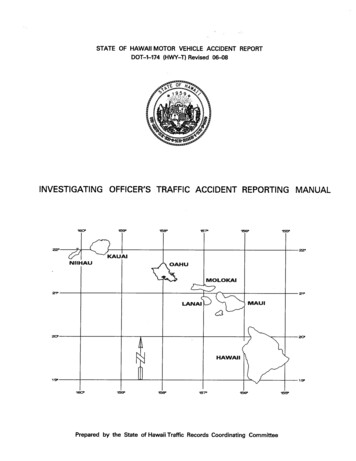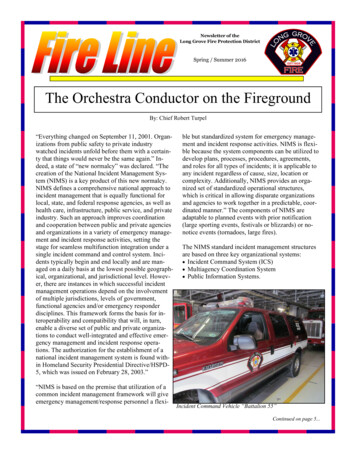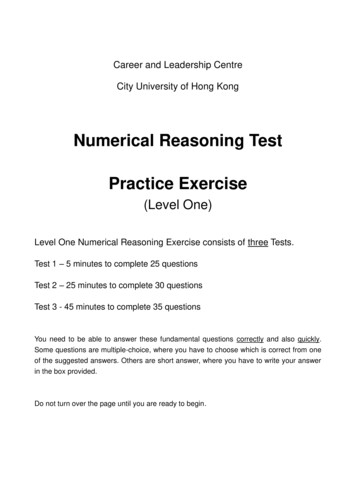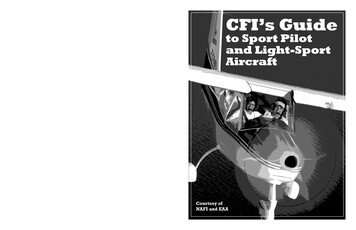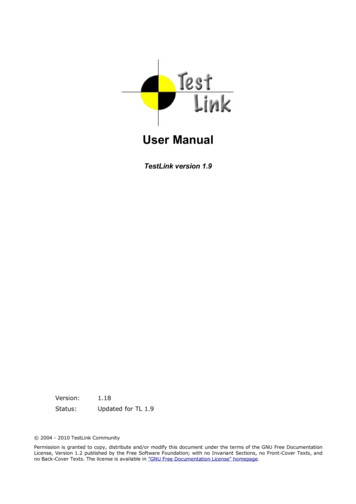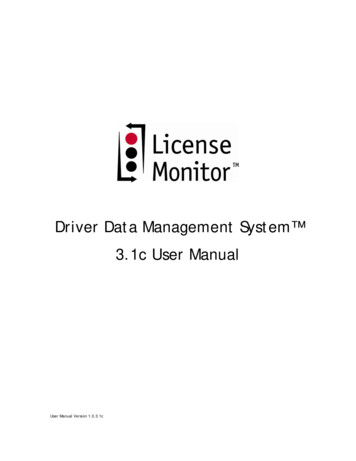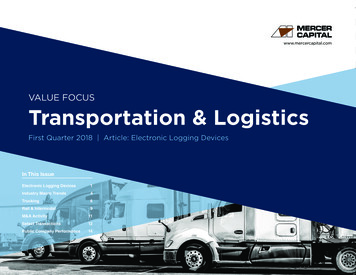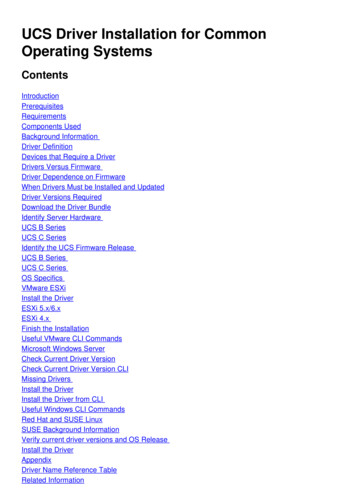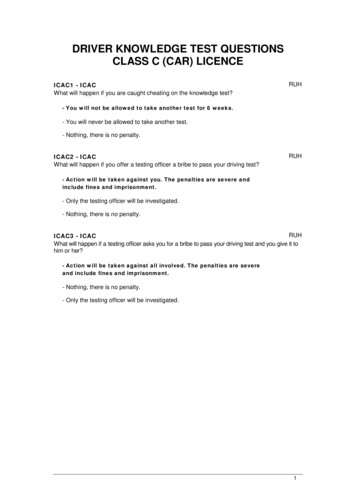
Transcription
DRIVER KNOWLEDGE TEST QUESTIONSCLASS C (CAR) LICENCEICAC1 - ICACWhat will happen if you are caught cheating on the knowledge test?RUH- You will not be allowed to take another test for 6 weeks.- You will never be allowed to take another test.- Nothing, there is no penalty.ICAC2 - ICACWhat will happen if you offer a testing officer a bribe to pass your driving test?RUH- Action will be taken against you. The penalties are severe andinclude fines and imprisonment.- Only the testing officer will be investigated.- Nothing, there is no penalty.RUHICAC3 - ICACWhat will happen if a testing officer asks you for a bribe to pass your driving test and you give it tohim or her?- Action will be taken against all involved. The penalties are severeand include fines and imprisonment.- Nothing, there is no penalty.- Only the testing officer will be investigated.1
GENERAL KNOWLEDGE SECTIONCG001 – General KnowledgeCan a P1 or P2 provisional driver legally instruct a learner driver?RUH- No.- Yes, provided the provisional driver has held a P2 licence for more than 6 months.- Yes, provided L and P1 or P2 plates are displayed.CG002 – General KnowledgeTo progress to a P2 provisional licence, a P1 provisional driver must hold a P1 licencefor a minimum period of -RUH- 12 months.- 18 months.- 24 months.CG006 - General KnowledgeIf one or two of your wheels run off the edge of the roadway, you should -RUH- Slow down gradually and ease back onto the road.- Slow down quickly by braking hard.- Increase your speed and drive back on the road.CG007 - General KnowledgeIf there are no lanes marked on the road, you should drive -RUH- Near to the left-hand side of the road.- Anywhere on your side of the road.- Along the middle of the road.CG010 - General KnowledgeIf you intend to turn left, are you required to give a signal?RUH- Yes, if turn signals are fitted to your vehicle.- No, if turning left from a lane marked left turn only.- No, if arrows are marked on the roadway.2
CG013 - General KnowledgeWhat is meant by this sign on or near a bridge?RUH- Slow down and be prepared to give way tovehicles travelling in the opposite direction.- Stop at all times before crossing the bridge and only giveway to pedestrians who may be crossing.- Do not overtake a vehicle travelling in the same direction.CG014 - General KnowledgeWhen reversing, you should -RUH- Take care and never reverse for a greaterdistance and time than is necessary.- Unbuckle your seat belt so you can reverse as quicklyas possible.- Sound your horn to warn other drivers.CG016 - General KnowledgeHow close can you park to another vehicle when parked parallel to the kerb?RUH- You must leave at least 1 metre front and back.- You must leave at least 2 metres from the front only.- You must leave at least 3 metres front and back.RUHCG017 - General KnowledgeWhere there is parallel kerbside parking, are you allowed to double-park alongside a parkedvehicle?- No, not at any time.- Yes, if delivering goods.- Yes, if not obstructing traffic.3
CG018 - General KnowledgeDo you have any responsibilities when opening a vehicle door on a roadway?RUH- Yes, you must not open a door if you are likely to cause danger toroad users or impede traffic.- No, any following traffic must stop if the door interferes with its progress.- No, there is no regulation to cover this situation.CG027 - General KnowledgeAre you permitted to park on a median strip or traffic island?RUH- No, not at any time.- Yes, in daylight hours.- Yes, but for no more than 30 minutes.CG028 - General KnowledgeAre you permitted to park in the direction of the arrow?RUH- No, not at any time.- Yes, provided no taxis are using the area.- Yes, if you are carrying two or more passengers.CG029 - General KnowledgeWhen driving at sunset or dawn on a dark day, what should you do?RUH- Turn on your lights on low beam.- Keep your sunglasses on to cut down headlight glare.- Turn on your hazard warning lights.RUHCG030 - General KnowledgeYou are driving at night with your headlights on high beam. When should you dip your headlights?- When within 200 metres of the vehicle ahead or an oncoming one.- When within 200 metres of an oncoming vehicle only.- Never, you are allowed to drive with your lights on high beam at all times.4
RUHCG031 – General KnowledgeYou are driving in a 60 km/h zone, with only one lane for traffic in your direction. You see a busahead (with this sign displayed on the rear) signalling its intention to pull out from a bus stop, youshould - Slow down, and give way to the bus as it haspriority.- Sound your horn to stop the bus from pulling out.- Continue at your normal speed as the bus does not havepriority.CG032 - General KnowledgeIs it an offence to obstruct clear vision of your number plates?RUH- Yes, at any time.- Yes, but it is legal for a towbar or bicycle rack to cover the rear number plate.- No, you are allowed to cover your number plates if you want to.CG034 - General KnowledgeBefore driving on a freeway, which of the following should you do?RUH- Make sure your vehicle has enough fuel, oil, water and the correcttyre pressure.- Take your street directory in case you get lost.- Take something to calm your nerves before driving.CG035 - General KnowledgeWhat must you do if you miss your exit on a freeway?RUH- Continue until you reach the next appropriate exit.- Stop, and reverse back along the freeway to the exit you missed.- Stop immediately and turn around.CG036 - General KnowledgeAs you leave a freeway, which of the following should you check?RUH- Your speed.- Fuel gauge.- Windscreen wipers.5
CG037 - General KnowledgeWhen can a private car travel in a lane marked by this sign?RUH- Only within 100 metres of making a turn.- When carrying at least two passengers.- Only to overtake another vehicle.CG038 - General KnowledgeAre you permitted to drive a car towing more than one trailer?RUH- No, not at all.- Yes, if the combined length of vehicle and trailers does not exceed 15 metres.- Yes, provided you have held a licence for two years.CG039 - General KnowledgeWhat must you do when you are towing a caravan to help other vehicles overtake?RUH- Keep at least 60 metres behind heavy vehicles or other vehiclestowing caravans.- Drive at least 25 km/h below the speed limit.- Stop immediately and let the faster vehicle overtake.CG040 - General KnowledgeAre you permitted to tow a caravan with a person riding in the caravan?RUH- No, not under any circumstances.- Yes, provided you do not exceed 60 km/h.- Yes, if the person(s) in the caravan are over 12 years of age.CG042 - General KnowledgeBefore driving a long distance at fast speed or carrying a full car load, you should -RUH- Check your tyre pressure, and if necessary, increase it to what themanufacturer recommends.- Make sure you have a street directory, so you know where you are going.- Have a large meal and a cup of coffee.6
RUHCG043 - General KnowledgeIf an oncoming vehicle crosses the centre line and is coming straight at you and you cannot stop,you should - Brake, look for room to the left, sound your horn and flash your lights.- Slow down and hope that the driver will turn away.- Drive onto the wrong side of the road and hope the other vehicle does not do thesame.RUHCG044 - General KnowledgeIf you are involved in an accident where your vehicle needs to be towed away and the Police doesnot attend the crash scene, you - Must report the accident to the Police Station nearest to where theaccident happened within 24 hours.- Do not need to report the accident to the Police.- Only need to report the accident to the Police if someone was injured.RUHCG045 - General KnowledgeIf your vehicle is involved in an accident (regardless of the damage), what details must you give, tothe other driver(s), if asked?- You must let them see your licence,take details, and give the name andaddress of the vehicle's owner.- No details at all until you have contacted yourinsurance company.- Only your name and address details if aPoliceman asks for them.7
RUHCG046 - General KnowledgeIf a vehicle you are driving is involved in an accident and a person is injured, what must you doafter stopping?- Render every assistance and takeimmediate steps to have an ambulancenotified. Then call the Police.- Only call the Police if the accident also resultedin over 500 worth of property damage.- Report the accident to Police within seven days.CG047 - General KnowledgeStop signs or flashing lights at railway crossings should always be obeyed, because -RUH- Trains are fast, heavy and cannot stop quickly.- Pedestrians might be crossing.- Car brakes often fail.CG048 - General KnowledgeYou should not drive across a railway level crossing when -RUH- Traffic is blocking the other side.- You are towing a caravan.- A station is nearby.CG049 - General KnowledgeYou should use your right-hand indicator when -RUH- You intend to move to the right, at any time.- You intend to slow down.- You are about to stop.CG052 - General KnowledgeWhen merging onto the freeway from the entrance, you should -RUH- Look for a large enough break in the traffic and adjust your speed soas to fit into the traffic flow.- Sound your horn, turn on your indicator lights and move onto the freeway.- Stop and check the traffic behind you on the entrance.8
CG053 - General KnowledgeIf you see a sign indicating road repairs are going on, you should -RUH- Slow down and watch for traffic controllers and instructions.- Stop immediately and wait for instructions.- Maintain the same speed.RUHCG055 - General KnowledgeYou see a broken yellow line painted on the roadway adjacent to the kerb. What does it mean?- Clearway restrictions apply - you must not stop during the clearwayhours.- You may at any time, park along this part of the road for 1 hour only.- Bicycle riders must ride along the yellow line.CG056 - General KnowledgeIf you see a horse and rider on the road what should you do?RUH- Slow down and give them plenty of room.- Sound your horn to warn the rider.- Speed up to pass the horse.RUHCG061 - General KnowledgeA friend lends you a van that has seats for ten passengers. What type of licence do you need todrive this type of vehicle?- A car licence.- A heavy rigid vehicle licence.- A small bus licence.RUHCG062 - General KnowledgeWhat are you required to do if you develop a serious medical condition that could affect yourdriving?- Once you become aware of the condition you must notify the RTA.- Hand your licence in at the nearest police station.- Tell your doctor and let him or her notify the RTA.9
RUHCG063 - General KnowledgeA friend lends you his car. It is very noisy and blows a lot of smoke. He tells you the vehicle hasbeen given a defect notice but it's still OK to drive it. What should you do?- Before you borrow the car check the defect notice to make sure it islegal to drive the car.- Borrow the car, but always drive it 10 Km/h below the speed limit.- Borrow the car but only drive on streets where the car will not be a danger toothers.RUHCG064 - General KnowledgeYour car registration expires today. You have your car inspected for registration renewal but it failsthe inspection. What should you do?- After today you must not drive the car until it has been repaired,passed another inspection and registered.- You have seven days to have the car repaired, after which the RTA considers it tobe unregistered.- Go to the RTA and ask them to renew your registration and tell them you will soonget the car fixed.RUHCG067 - General KnowledgeYou buy a car and find that the spare tyre is smooth; the tread is only just visible. If you get apuncture will it be legal to drive the car with a smooth spare tyre?- No, it's illegal to drive a car with a smooth tyre even if it is the spare.- Yes, but you must get the puncture fixed within 24 hours.- Yes, if the tyre is correctly inflated and the side walls of the tyre are in goodcondition.RUHCG068 - General KnowledgeYou borrow a friend's car and find that the position of the driver's seat puts you sitting a long wayfrom the steering wheel and controls. What should you do?- Adjust the seat forward so it's right for you.- Put up with the discomfort; you should not adjust another person's seat.- Ask your friend for a cushion to place behind your back.10
RUHCG070 - General KnowledgeYou hold an unrestricted licence and are driving at 100 km/h in the country and pass this sign.What should you do?- Slow down to a speed that will allow you to stop toavoid crashing into farm animals on the road.- You can continue to drive at 100 km/h if there are fences to stopfarm animals from getting on the road.- For the next 5 kilometres you must not exceed 60 km/h unless youpass an end farm animals speed limit sign.RUHCG071 - General KnowledgeYou are turning right from one of two right turn only lanes. How should you use your indicators?- Indicate with your right hand signal thesame as any other right hand turn.- You should not indicate at all because it mightconfuse other drivers.- Indicating in this situation is optional. Give a righthand signal if you think it will help other road users.RUHCG075 - General KnowledgeYou are driving on a freeway and realise you forgot something at home. You want to go back for it.Can you do a U-turn on this road?- No, not at any time.- Yes, any time.- Yes, providing you use the gravel joining roads.RUHCG076 - General KnowledgeYou have a six year old child with you in your car. You have just parked so you can collect aprescription from the chemist. You should - Take the child with you.- Leave the child in the car.- Ask an older person sitting nearby to watch the child.11
CG078 - General KnowledgeYou want to leave your automatic car parked on a street sloping uphill. You should -RUH- Put the handbrake on and put thetransmission in "P" (park).- Park only on flat areas.- Turn the wheels away from the kerb.CG080 - General KnowledgeYou have just passed this sign. Can you park on this road ?RUH- No, not at any time.- Yes.- Yes, but only in daylight hours.CG082 - General KnowledgeWhere there are double dividing lines, you may park -RUH- At least three metres from the dividing lines.- At least two metres from the dividing lines.- One metre from the dividing lines.RUHCG083 - General KnowledgeIf there are no signs or markings to advise you, can you choose any of these methods of parking?- No, only N is correct.- Yes. M, N and O are all legal.- Yes, N is best but M and O are quite legal.12
CG084 - General KnowledgeYou should angle park -RUH- Where there are markings or a signindicating angle park.- Where the road is very wide.- Where there is plenty of room from thecentre line.RUHCG086 - General KnowledgeThis bridge has only just enough room for two vehicles. As you come close to it you should - Slow down and pay extra attention.- Sound your horn to warn the other driver.- Maintain your speed, keeping to the limit.CG087 - General KnowledgeWhich side mirror is adjusted best?RUH- Mirror A.- Mirror B.- Mirror C.13
CG088 - General KnowledgeYou should be particularly careful at this intersection because -RUH- The building blocks a good view of theside street.- Intersections cause crashes.- It looks a bit tricky.RUHCG089 - General KnowledgeYou are in busy traffic and slow down for a bicycle rider. A driver behind you beeps a horn andpressures you to go around the bike and drive faster. How should you respond?- Resist the pressure, stay calm and overtake the cyclist when it issafe.- Overtake the bike quickly and speed up to stop the other driver becomingaggressive.- Go slower because the slower you go the safer you are.CG090 - General KnowledgeYou hear the siren of an ambulance approaching you from behind. You should -RUH- Move into the left lane.- Slow down to the speed of other traffic.- Continue at the same speed.14
RUHCG091 - General KnowledgeYou are driving along this road. You hear an ambulance's siren and see the ambulance in yourmirror. You should - Move to the left and make way for theambulance.- Turn into a driveway on the right hand side of theroad.- Move to the right and make way for the ambulance.RUHCG092 - General KnowledgeYou are about to make a right hand turn at this intersection. You have the green light. You hear asiren and then see that a fire truck will soon overtake you. You should - Stop and let the fire truck overtake you.- Continue and make the turn because you havethe right of way.- Speed up to beat the fire truck.CG093 - General KnowledgeWhen you come across roadworks -RUH- You must obey the signs that are displayed at all times.- You only have to obey the signs when there are workers about.- You only have to obey the signs during working hours.CG094 - General KnowledgeGenerally, if you hear the siren of an emergency vehicle you should -RUH- Pull over to the left until the emergency vehicle passes.- Immediately come to a stop.- Let the emergency vehicle pass and follow it closely behind.15
RUHCG095 - General KnowledgeYou are approaching a green light in vehicle A. An ambulance sounding its siren is approachingthe same intersection and has a red light. You should - Slow down and stop if necessary to preventgetting in its way.- Keep driving because you have the green light.- Pull over to the left before you reach the intersection.CG099 - General KnowledgeWhen you see these lights flashing on the back of a bus, what should you do?RUH- Drive carefully at no more than 40 km/h.- Overtake the bus only while the lights are flashing.- Stop and wait for the lights to stop flashing.RUHCG100 - General KnowledgeYou are driving at night and there is no other traffic around you. When can you use your headlightson high beam?- On any road, even if there are street lights.- On any road where the speed limit is above 80 km/h.- Only on roads that do not have street lights.CG102 - General KnowledgeYou want to park your vehicle for a short time. It is night time. You should -RUH- Pick a visible position or leave the parkingor hazard lights on.- Park on the footpath.- Leave your headlights on high beam.16
CG103 - General KnowledgeYou drive up to a corner where you see some loose gravel on the road. You should -RUH- Slow down.- Check the mirrors and change lanes.- Speed up and drive over the gravel as quickly as possible.CG105 - General KnowledgeWhen you are driving on a two-lane freeway, which lane should you choose?RUH- The left lane unless you are overtaking.- Whichever lane has the least traffic.- The right lane to avoid slow-moving vehicles.17
CG106 - General KnowledgeWhen there are three lanes on a freeway -RUH- The right lane is reserved for overtaking.- The right lane is for emergency vehicles only.- The right lane is for avoiding most traffic.CG110 - General KnowledgeWhen you see the headlights flashing on the front of a bus, what should you do?RUH- Be careful, there may be children about.- Drive past the bus only while the lights are flashing.- Stop and wait for the lights to stop flashing.CG112 - General KnowledgeYou are driving your vehicle along a street and want to stop fora short time. Are you allowed to double park your vehicle (thatis stand it on the road alongside a parked car)?RUH- No, never.- Yes, provided you do not leave the vehicle.- Yes, provided you stop for a short time only and turn onyour hazard warning lights.CG113 - General KnowledgeLooking at the diagrams, how far from the approachside of a bus stop or a railway crossing are you allowedto stand or park your vehicle?RUH- At least 20 metres.- At least 50 metres.- At least 5 metres.18
CG114 - General KnowledgeAre you allowed to use a hand-held mobile phone while driving a car?RUH- No.- Yes, but only when you stop at intersections.- Yes, but you must hold the steering wheel with at least one hand.CG115 - General KnowledgeAre you required to carry your driver’s licence with you every time you drive?RUH- Yes.- No it is only needed on long trips.- No, being licensed is enough.CG116 - General KnowledgeBicycle and motorcycle riders have the same rights to use the road as other motor vehicledrivers. They are, however, more at risk in traffic because -RUH- They are harder to see in traffic and do not have the same protection asmany drivers.- They are careless and do not obey road rules.- They ride too fast and do not turn their lights on.CG117 - General KnowledgeTo drive safely, you need to concentrate and be able to monitor everything that ishappening on the road. To do this, you need to -RUH- Continually scan the road, looking ahead, to the sides, checking sideand rear mirrors and anticipate what may happen.- Turn all your attention only to the road ahead.- Ask other occupants in the vehicle to watch out for possible dangers.CG118 - General KnowledgeIf you are driving towards a road works zone and a traffic controller displays a stop signyou must -RUH- Stop your vehicle and follow the directions of the traffic controller.- Stop and then proceed if you think it is safe.- Slow down and continue through the road works zone.19
CG119 - General KnowledgeIf you are driving through a road work zone in the lefthand lane and you see this sign you should -RUH- Merge to the right and give way to othertraffic.- Speed up to get in front of any cars traveling inthe right hand lane.- Stop and wait for directions.CG120 - General KnowledgeWhere must L or P plates be displayed on a vehicle -RUH- On the front and back of the exterior of the vehicle.- Anywhere including on the dashboard.- Anywhere inside the windows but only if they are not tinted.CG121 - General KnowledgeWhen displaying L or P plates, how much of the letter must be clearly visible?-RUH- All of the letter L or P.- Only enough of the letter so it is clear whether it is an L or P.- Most of the letter.CG122 - General KnowledgeDo bicycle riders have the same rights and responsibilities as drivers and motorcycleriders?RUH- Yes.- No, they must always ride on the footpath.- No, they must give way to cars at all times when riding on the road.CG123 - General KnowledgeBefore getting out of your vehicle you must -RUH- Check your mirrors and blind spots for pedestrians, bicycles or othervehicles.- Check your seatbelt is back in place.- Check your headlights are turned off.20
ROAD SAFETY SECTIONAD004 - Alcohol and DrugsTo reduce the effect of alcohol before driving or riding you should -RUH- Wait. The time depends on how much you have drunk.- Drink black coffee.- Have a glass of water.AD009 - Alcohol and DrugsBefore driving a motor vehicle or riding a motor cycle it is safest -RUH- Not to drink any alcohol.- Drink 1 nip of spirits (30 ml or 1 oz).- Drink 1 middy (285 ml) of light (low alcohol) beer.AD012 - Alcohol and DrugsIs it an offence to refuse to take a POLICE breath test?RUH- Yes, always.- No, if you say you haven't been drinking alcohol.- No, if you are a learner driver.AD013 - Alcohol and DrugsIf you take medicine and then drink alcohol -RUH- It can have a particularly bad effect on your driving ability.- The alcohol will have less effect than if taken alone.- Your ability to react to emergencies will improve.RUHAD014 - Alcohol and DrugsIf you are driving a bus, taxi, hire-car, heavy motor vehicle (over 13.9 tonnes Gross Vehicle Mass),or a vehicle with a dangerous load, it is an offence when the level of alcohol in your blood reaches - 0.02.- 0.05.- 0.08.21
AD015 - Alcohol and DrugsHaving 1 or 2 alcoholic drinks before driving -RUH- Will affect your reactions and judgement.- Improves your driving ability.- Has no effect on your driving ability.AD016 - Alcohol and DrugsEven if you feel unaffected after drinking alcohol, you should -RUH- Be aware that your abilities are decreased.- Drive, but avoid using freeways.- Spend more time than usual looking in the mirrors.AD025 - Alcohol and DrugsAlcohol is a depressant. This means -RUH- It slows down how quickly your brain works.- It speeds your brain up so you can work better.- It makes you calm down and think more clearly.AD026 - Alcohol and DrugsAfter drinking alcohol you could -RUH- Misjudge speed (your own and others).- Be able to drive the same as you normally can.- Be able to pay close attention to details in the traffic.AD031 - Alcohol and DrugsIf you are going out and going to drink alcohol, the best way to avoid having to drinkand drive is to -RUH- Organise before hand a way of getting home where you are not thedriver.- After you have had a few drinks, start to think about how you will get home.- Wait for one hour after your last drink before you drive home.AD033 - Alcohol and DrugsWhen drivers have been drinking, the crashes they are involved in are generally -RUH- More serious.- Less serious.- About the same.22
AD034 - Alcohol and DrugsOn Thursday, Friday and Saturday nights, how many serious crashes involve alcohol?RUH- About 50%.- About 30%.- About 10%.AD038 - Alcohol and DrugsWhat is the safest way to stay under the legal alcohol limit?RUH- Not drinking any alcohol.- Buying a breathalyser (alcohol measuring instrument).- Exercising and drinking black coffee.RUHAD041 - Alcohol and DrugsIf you hold a learner or provisional licence class what is the Blood Alcohol Concentration (BAC)limit?- Zero.- 0.02.- 0.05.DR001 - Alcohol and DrugsIf you are taking any sort of medicine, you should -RUH- Find out from your doctor or chemist whether the medicine or drug willaffect your driving and act accordingly.- Only drive during the day after taking the medicine or drug.- Only drive a motor car not a heavy vehicle.DR002 - Alcohol and DrugsBefore taking any drugs and then driving it is most important to -RUH- Know what the effects of the drug are.- Plan to have some other person with you.- Have some food in your stomach.DR004 - Alcohol and DrugsIf you have used illegal drugs you -RUH- Must not drive.- May drive only in light traffic.23
- Should drink coffee before driving.DR009 - Alcohol and DrugsIf you are affected by a legal drug, such as a medicine (e.g. cold or allergy tablets) -RUH- You must not drive.- You must have a passenger to help you drive.- You may drive only in daylight hours.RUHDR010 - Alcohol and DrugsYou want to drive your car but you have a very bad headache. A friend gives you some of theirheadache tablets to kill the pain. What should you do before you take these tablets?- Read the label and confirm they are not prescription drugs and thereare no special warnings on the label.- Ask your friend if the tablets have affected them.- Drink a large glass of milk because this reduces the adverse effects of medicinesand drugs.RUHDR011 - Alcohol and DrugsIf you are taking several medications and you want to drive, you should - Ask your doctor if the combination of drugs will make it dangerous todrive.- Drive carefully around your local streets to see if you are affected.- Ask your passengers to let you know if you are not driving as well as you should.24
RUHBI001 – Bicycle SafetyYou are driving on a road with a speed limit of 60km/h or less. How much space must you leavewhen passing a bicycle rider?- at least 1 metre.- at least 1.5 metres.- as much as you think is safe.RUHBI002 – Bicycle SafetyYou are driving on a road with a speed limit above 60km/h. How much space must you leavewhen passing a bicycle rider?- at least 1 metre.- at least 1.5 metres.- as much as you think is safe.RUHBI003 – Bicycle SafetyIn order to provide the minimum safe passing distance for bicycle riders, are you permitted to crosssingle and double continuous lines?- no.- yes, always- yes, but you must have a clear view of any approaching traffic and itmust be safe to do so.25
FD001 - Fatigue and Defensive DrivingUnder good conditions, when driving behind any vehicle, at any speed, you should -RUH- Stay at least three seconds behind the vehicle in front of you.- Drive as close to the vehicle in front as possible.- Stay one second behind the vehicle in front of you.FD002 - Fatigue and Defensive DrivingWhen driving in wet weather, your vehicle will -RUH- Take longer and further to stop, so slow down.- Stop in the same distance as on a dry road.- Handle better, so you can go faster.FD003 - Fatigue and Defensive DrivingAt night, if an oncoming vehicle's headlights dazzle you, you should -RUH- Slow down, until your eyes recover.- Watch the centre line of the road.- Close your eyes for a short time until they recover.FD004 - Fatigue and Defensive DrivingIf you get sleepy while driving, it is best to -RUH- Stop, rest, and change drivers if possible.- Turn on the radio very loud.- Turn on the air conditioning or open the windows.FD005 - Fatigue and Defensive DrivingIn wet weather when it becomes hard for you to see, you should -RUH- Turn on your headlights, slow down, and double your followingdistance behind the vehicle in front.- Turn your headlights on high beam.- Flash your headlights to warn other drivers.26
FD006 - Fatigue and Defensive DrivingIf you are driving and it starts to rain, you should -RUH- Slow down using the brake gently, since rain and oil may create aslippery surface.- Put your lights on high beam so you can see better.- Put your hazard warning lights on and increase your speed to avoid the rain.RUHFD007 - Fatigue and Defensive DrivingWhen driving on a slippery wet road, for example, one covered in early morning dew, your vehiclewill - Take longer and further to stop.- Be heavier to steer.- Be easier to steer and handle.FD010 - Fatigue and Defensive DrivingWhy should you avoid heavy braking on a wet road?RUH- Your wheels may skid and cause a loss of control.- If the wheels lock up your handbrake may not work.- You might wet pedestrians walking along the footpath.FD011 - Fatigue and Defensive DrivingAt night you should -RUH- Leave a longer gap behind the vehicle in front.- Use your hazard warning lights when overtaking another vehicle.- Drive closer to the vehicle in front so they can see you better.RUH8FD012 - Fatigue and Defensive DrivingWhen it is very foggy during the day or night and your v
- Drive onto the wrong side of the road and hope the other vehicle does not do the same. CG044 - General Knowledge : RUH If you are involved in an accident where your vehicle needs to be towed away and the Police does not attend the crash scene, you -
